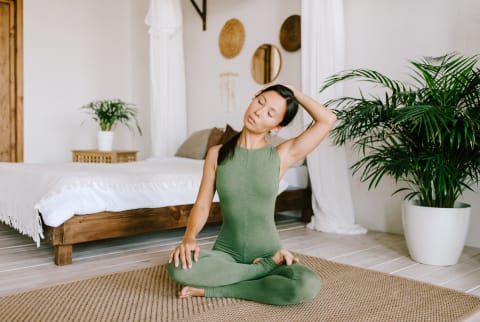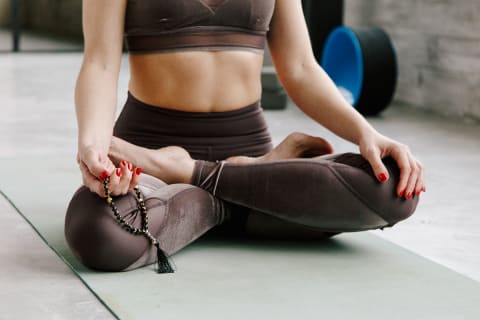Advertisement
You're Already Meditating: How To Access A Less-Stressed State

There's no better time than the present to learn how to tap into new dimensions of less-stress living through meditation. For all things connected to unlocking the mind and finding clarity, we turn to world-renowned expert Deepak Chopra, author of Total Meditation: Practices In Living the Awakened Life. Stress is complicated, but there are everyday habits you can practice to help maintain your sense of internal balance. In his own words, Chopra explains:
"People drop their meditation practice mostly because they can't fit it into a crowded day. I propose that your mind wants to be in a meditative state naturally, and you can access it anytime you wish. No special time needs to be set aside. You simply notice when you are distracted, upset, or stressed, and in less than a minute you can return to a calm, centered state once more. Total meditation is very simple but also very different from how people approach meditation right now, and the more you make it a habit the more you will live in a state of open, free, creative, and blissful awareness."
Meditation doesn't have to be an hours-long event or onerous daily task. It's all about attention, intention, and tuning into yourself. For more information, read and get inspired by the excerpt from his book below, before buying your own copy here.
Total Meditation: Practices in Living the Awakened Life
The mind is prone to habit—it gives us mostly the same thoughts over and over. These thoughts are generally good enough to get by with in life, but they don't reveal anything new. Asking for an insight is a conscious process, and once you learn how to do it, the process comes naturally. You'll be astonished by how the world around you reveals itself in new and beautiful ways.
How to ask for insight:
- Sit alone in a quiet place and center yourself. Do this by closing your eyes, taking a few deep breaths, and placing your attention in the region of your heart.
- You silently pose a question to yourself.
- You let go of the question and wait for a response.
- You trust that the answer will be given.
- At some time, either quickly or later, the response comes spontaneously.
There is nothing arcane about this process. Countless times in our life we stand back and ask, usually in bewilderment, "What am I doing wrong?" or "What should I do next?" Most of the time, however, we don't ask the question in the right frame of mind. We are usually stuck or confused. We've met with resistance and need a way out. The situation is already putting pressure on us, and therefore we are trying to find an answer while feeling stressed. This is what I call being stuck at the level of the problem. Insight meditation is about going to the level of the solution, which is where your true self is located. When you intentionally ask an important question or ask for insight in a relaxed state, you open a doorway to increased consciousness, and hence answers are more likely to come to you.
The body-mind is a whole; therefore, insights aren't just mental. You can feel them as sensations such as surprise, delight, or an "Aha!" moment of making a new discovery. These indications can help you tell how insights differ from everyday thoughts. The beauty of having your own insight is that it will excite and motivate you.
Let's try insight meditation around a key goal that drives us all: safety and security. I've provided a handful of insights to get you started. Some are insights gained from my own journey. Others are the insights of saints, sages, and spiritual guides in the world's wisdom traditions. Just read them over before you start your meditation, as a way to focus your mind on the goal.

Exercise: Insight Meditation for Safety and Security
Insights:
You are only as safe as you feel. Your true self is never under threat.
The world reflects your inner safety or inner insecurity.
When you are whole, you are totally safe.
To be safe is to be present here and now.
At the level of the true self, you are perfectly safe and secure. There is no threat that can shake your true self from this knowledge because it is innate, coming directly from pure consciousness. Obviously, everyday life brings situations that feel the exact opposite. The news is filled with stories about disaster and imminent danger. Worst-case scenarios run through our minds when we feel threatened. Stress itself is a threat, even in small doses because it triggers the stress response, which we inherited as a way to cope with threats by running away (flight) or physically standing up to danger (fight).
A breakthrough occurs in total meditation because you begin to experience the truth: Being safe is a state of awareness.
Today you can get closer to living in a state of awareness that makes you totally safe and secure by reflecting on the below three questions. It will probably be most effective simply to choose one question. Let your attention be attracted to the issues that are calling out to you personally.
What am I doing right?
Any step that gets you feeling safe in yourself is right. The basic move is to go into meditation mode whenever you start to feel pressured or insecure. By doing this, you shift your awareness away from stress.
- Get to a quiet place, take a few deep breaths, and pay attention to your body's signals. When you feel tightness, strain, discomfort, or pain, attend to these sensations.
- Let your attention go to the area of discomfort as you breathe slowly and evenly. Don't force anything. Be patient and let your awareness ease the discomfort naturally.
- Notice the people around you and their state of awareness. Stress goes viral very easily. You want to minimize how much time you spend with people who feel pressured or put pressure on you.
- We are all in the habit of being fascinated by bad news, natural disasters, and all kinds of catastrophes.
- Get in the habit of paying the least attention you can to such stories. If they make you feel anxious or unsafe, say silently, "I am not in danger here," and wait until you feel safe again.
- Be around people who are secure and confident in themselves. Often they are the quietest, most comforting kind of people.
- Create a surrounding that reflects the state of inner security. Focus on peace and quiet, orderliness, visual beauty, and light.
What isn't working for me?
Any step that makes you feel unsafe in yourself isn't working for you. Being worried or anxious never resolves a situation.
- At the first sign of worry, center yourself, and find your calmness again.
- Being around insecure, anxious, and defensive people may make you feel stronger or give you the sense that you belong. But this is the wrong kind of belonging. It reinforces the belief that the world is unsafe and you are unsafe in it.
- Dwelling on worst-case scenarios doesn't work. You waste time and energy on something that needlessly takes you out of your inner comfort zone.
- Avoid the urge to justify yourself to others. Being defensive is no protection. The more defensive you are, the more insecure is your inner life.
- Giving in to someone else makes you feel you are not strong enough in yourself. Avoid anyone who doesn't treat you as an equal, with respect and consideration.
- Taking outside threats personally doesn't work to keep you safe. If bad news doesn't actually affect you, send hopeful and compassionate thoughts to those who are affected, then turn your attention to something else.
- Latching on to someone else's strength doesn't work to make you safer. You will become dependent, and whenever you have to stand up for yourself, you will feel self-doubt and insecurity.
- Relying on more money, status, power, or possessions to make you safe doesn't work. You are only hiding from your own fear and insecurity. Make inner security your goal, always.
What is my next step?
- First priority: Do more of whatever you are doing right. Do less of whatever isn't working for you.
- Visualize white light in the area of your heart. Sit quietly and commune with this light.
- Set aside time to go somewhere that feels totally peaceful and safe. Take sanctuary in this place, shutting out any external threat or pressure.
- Let the feeling of this place merge with you so that inside and outside both radiate the same peace.
- Take time to support someone you know who needs help. Bring a sense of comforting, reassuring, and being of service to this person. In this way you share your own inner sense of security. Being an anchor for someone else expresses your inner strength and security.
- Look at your area of greatest stress: work, family, or relationships. Find one way today to reduce the stress. Examples: Talk to a person causing you stress and calmly ask for help. Avoid office politics by making yourself available to anyone without taking sides. Reduce the noise and distraction at home. Honestly share feelings with your partner, avoiding accusations and blame.
Your true self has a truth to reveal in any situation. Once you learn to seek answers in silent awareness, you will discover that this method is the right way to make choices.


















